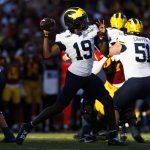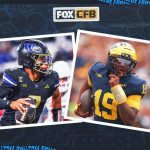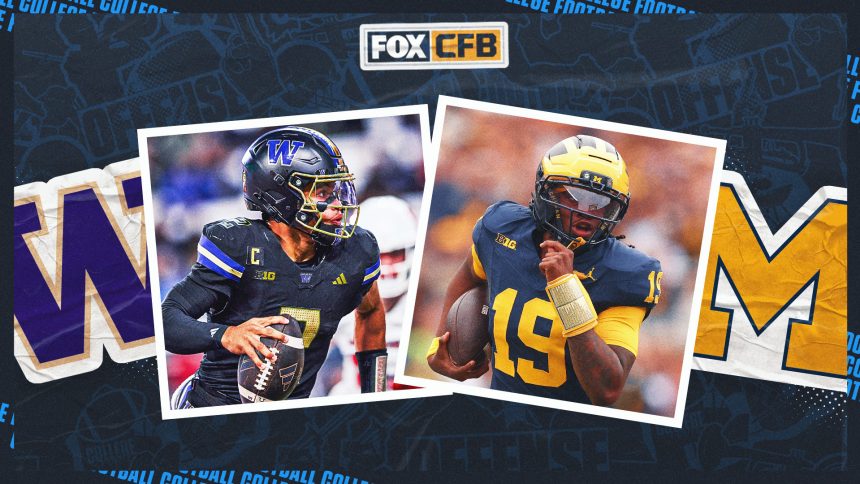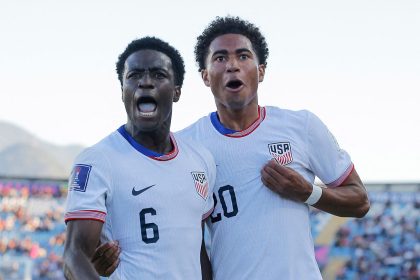Both Michigan and Washington enter Saturday’s showdown with something to prove. For the Wolverines, it’s about salvaging a season that’s already veered off course. For the Huskies, it’s about showing they belong among the Big Ten’s elite — and that their sophomore quarterback deserves national attention.
Demond Williams has quietly put together one of the most productive seasons in the country. But with the national spotlight rarely landing on the West Coast, this “Big Noon Saturday” showdown could be his breakout moment. For Michigan, the challenge runs deeper. A loss to USC knocked the Wolverines out of the Top 25 and reignited concerns about identity and how far the program has drifted from its Harbaugh-era dominance.
Ahead of Saturday’s game, FOX Sports writers RJ Young and Michael Cohen dig into two central questions: What’s held Demond Williams back from national recognition — and could this be his coming-out party? And what is Michigan’s identity under Sherrone Moore, and what will it take for the Wolverines to bounce back?
1. Washington QB Demond Williams is quietly putting together one of the most impressive seasons of any quarterback in the country. Why hasn’t Williams gotten the respect that other QBs have this season, and could this be the stage that pushes him into the national spotlight?
RJ Young: He got plenty of respect from Ohio State. As a matter of fact, defensive coordinator Matt Patricia was the first coach to publicly compare Williams to Kyler Murray.
ADVERTISEMENT
Heading into their game against the Buckeyes, the Huskies averaged 58 points per game and 568 yards with offensive coordinator Jimmy Dougherty dialing up daggers for Demond to toss. And, in every game save that Ohio State one, Williams has hit had exceptional accuracy. Even after Washington’s 24-6 loss to the Buckeyes, Williams ranks fourth in the Big Ten in passing yardage (1,628 yards) and leads all Big Ten QBs in rushing (382 yards). Williams has 14 touchdowns this season and has just one interception in the first half of the season.
The Huskies sophomore quarterback turned heads with his 538-yard performance last week against Rutgers — the first Husky to throw for at least 400 yards and rush for 100 yards in a single game in program history. Now, on one of the sport’s biggest stages, Williams has a chance to make a powerful statement — one strong enough to spark national media interest in what he’s done and what he’s capable of doing in 2025.

Demond Williams Jr. #2 of the Washington Huskies throws a pass during the second quarter against the Rutgers Scarlet Knights. (Photo by Blake Dahlin/ISI Photos/ISI Photos via Getty Images)
Michael Cohen: Let’s get the obvious reason out of the way first: Generally speaking, it’s difficult for standout players on the West Coast to receive as much recognition as they deserve when most of their games kick off so late at night.
Washington’s season opener against Colorado State, which included 226 passing yards, 68 rushing yards and one touchdown from Williams, began at 11 p.m. ET and wasn’t on national television. Washington’s second game against UC Davis, which included 254 passing yards, 64 rushing yards and two total touchdowns from Williams, began at 11 p.m. ET and wasn’t on national television. Washington’s third game against Washington State, which included 298 passing yards, 88 rushing yards and five total touchdowns from Williams, began at 7:30 p.m. ET and was on national television but kicked off at the same time as No. 9 Illinois vs. No. 19 Indiana and No. 4 Miami vs. Florida, among others. It wasn’t quite appointment viewing.
All of which means that the first time many fans and media members really watched Williams was when Washington hosted No. 1 Ohio State on Sept. 27, and that was far and away the Huskies’ worst offensive performance of the season. Williams completed 18 of 22 passes for 173 yards, zero touchdowns and zero interceptions while being relentlessly chased by the Buckeyes’ pass rush. It marked the first time in Williams’ career that he finished with negative rushing yards, mostly because sack yardage counts against quarterbacks’ final totals. That the game wasn’t even close — it ended as a comfortable 24-6 win for Ohio State — likely cemented certain opinions of Washington that weren’t overwhelmingly positive.
The other elephant in the room for Williams, a true sophomore, is the level of competition he’s faced outside of the aforementioned loss to the Buckeyes. Colorado State and Washington State — the two non-conference FBS teams Washington faced this season — now have a combined record of 5-7. And even the Huskies’ two Big Ten wins over Maryland and Rutgers, against whom Williams absolutely shined, are a combined 1-5 in conference games thus far. That’s not exactly the recipe for fans outside the Pacific Northwest to stand up and cheer.
But a nationally televised road game against Michigan, a legitimate college football blue blood? Now that’s the type of stage that can turn into a legitimate launching pad.
2. Now seven weeks into the season, what is the identity of this Michigan football team and what is needed for this team to bounce back after an unsettling loss to USC last weekend?
Michael Cohen: The disappointing answer for Michigan fans, whose hopes of a magical run toward the College Football Playoff are swiftly fading, is that it’s still unclear what the Wolverines’ identity might be under second-year head coach Sherrone Moore.
Everyone understood Moore’s background as an elite offensive line coach and high-level play caller alongside former coach Jim Harbaugh, for whom he was a critical cog in the program-wide rebuild that ended with a national championship. But discerning the type of team Moore has been trying to build since taking over for Harbaugh ahead of the 2024 campaign is far trickier given Michigan’s consistently inconsistent results on the field.
Some of that can be attributed to the Wolverines’ woeful quarterback play last fall, when neither Davis Warren, Jack Tuttle nor Alex Orji proved capable of performing at a Big Ten level. As a first-time head coach, Moore oversaw one of the worst offenses in college football — 129th in yards per game; 113th in points per game — and then promptly fired offensive coordinator Kirk Campbell, a holdover from Harbaugh’s staff and a man he promoted from quarterbacks coach.
But even after pushing all those factors aside, which, on its own, is something of a problematic exercise considering Moore is ultimately responsible for every personnel and staff decision, the 2025 season has done little to assuage the hollow feeling that Michigan still doesn’t know what it wants to be. Or, perhaps more accurately, what it’s capable of being given the noticeable lack of talent at several key positions: offensive line, wide receiver, defensive line and cornerback to name a few.
In theory, it seems clear that Moore would like to channel his offensive line background by prolonging the smash-mouth identity Michigan built under Harbaugh. But when the Wolverines are halfway through a season in which none of their starting offensive linemen look like All-Big Ten caliber players and that underachieving group has battled injuries, the goal of pounding teams to death seems entirely farfetched.
There are also moments when it appears that new offensive coordinator Chip Lindsey wants to showcase the downfield, aerial talents of five-star quarterback Bryce Underwood, the No. 1 overall recruit in the country, but with 14 dropped passes already this season and nearly a decade of subpar wide receiver development, it’s unlikely Michigan has the perimeter options to make that a viable plan.

Bryce Underwood #19 of the Michigan Wolverines reacts before the game against the USC Trojans. (Photo by Luke Hales/Getty Images)
Even the Wolverines’ defense, which was supposed to anchor this team as coordinator Don “Wink” Martindale returned for his second season, has displayed concerning signs of slippage through the first six games, especially when it comes to tackling, setting the edge and covering wide receivers on the back end. It was shocking to see how easily USC sliced Martindale’s group apart in a blowout road loss last weekend.
For Michigan, getting back on track has always meant returning to its roots of running the football and dominating the line of scrimmage. But for the first time in a long time, the Wolverines might not have enough talent in the trenches to do so.
RJ Young: Michigan’s identity isn’t in question. The Wolverines run the ball. They play defense. When they can’t do either well — as was evident in their 18-point loss to USC last week — deeper questions inevitably surface. But sometimes, it’s not that complicated. Michigan is at its best when it seizes an early lead and uses it to control the tempo, draining the energy from the game. The Wolverines thrive on the grind. They relish a fistfight in a phone booth. They take satisfaction in watching their opponent’s will slowly fade.
However, I understand why some would wonder if Michigan’s identity is simply their record: 4-2. This program was 4-2 after six games last year too. And while they are scoring more this year (29.5 points per game to 23.5) they’re also allowing more points (22.3 points per game to 18.7).
Sherrone Moore’s record as Michigan’s head coach is 10-7 overall, based on the 17 games he has coached since being named head coach — a stark contrast to the 40-3 overall mark and 29-1 Big Ten record the Wolverines posted under Jim Harbaugh over five seasons. Now, with Michigan outside the Top 25 for the first time this season, a loss to Washington would reinforce a familiar label for the Wolverines: mediocre.
RJ Young is a national college football writer and analyst for FOX Sports. Follow him @RJ_Young.
Michael Cohen covers college football and college basketball for FOX Sports. Follow him @Michael_Cohen13.
Want great stories delivered right to your inbox? Create or log in to your FOX Sports account and follow leagues, teams and players to receive a personalized newsletter daily!










